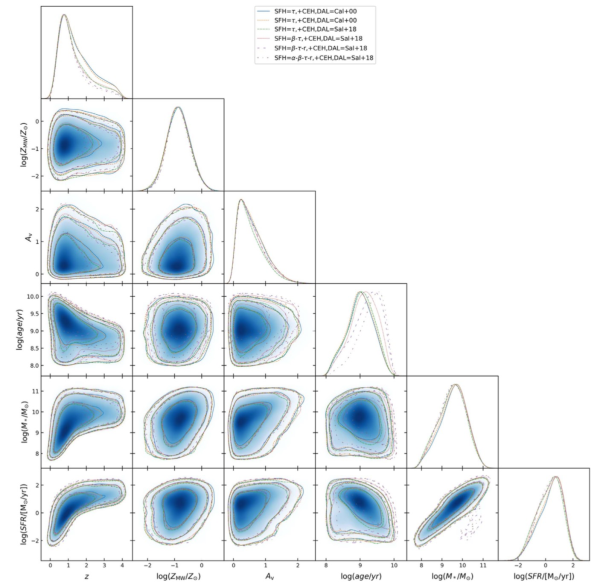Recently, a research paper authored by Associate Researcher HAN Yunkun from Yunnan Observatories of the Chinese Academy of Sciences, along with Professor FAN Lulu from the University of Science and Technology of China and Researcher ZHENG Xianzhong from Purple Mountain Observatory of the Chinese Academy of Sciences, among others, has been published in The Astrophysical Journal Supplement Series. The paper reports new advancements in the performance test for simultaneous photometric redshift and stellar population parameter estimation of galaxies in the China Space Station Telescope (CSST) wide-field multiband imaging survey.
Galaxies are the fundamental units that constitute the universe. Studying the formation and evolution of galaxies helps unravel the nature of dark matter and dark energy, presenting one of the most challenging issues in the field of modern astrophysics. The multi-band spectral energy distribution (SED) analysis of galaxies can be utilized to measure fundamental physical parameters of galaxies such as their redshift, stellar mass, and star formation rate. This approach serves as a crucial foundation for understanding the myriad complex physical processes associated with stars, interstellar medium, and supermassive black holes within galaxies. It represents a focal point in the field of galaxy research. The state-of-the-art James Webb Space Telescope (JWST) and the Euclid space telescope, along with the under-development CSST and Roman Space Telescope, among others, will provide a massive amount of multi-wavelength data. This presents a tremendous opportunity for a deeper understanding of the formation and evolution of galaxies. Simultaneously, it poses significant challenges for the development of SED synthesis and analysis methods and tools.
In recent years, many large international teams have actively been developing their own methods and tools for multi-band SED synthesis and analysis of galaxies. As early as 2012, researchers at Yunnan Observatory, including HAN Yunkun and others, embarked on this endeavor (Han & Han, 2012, 2014, 2019). They systematically developed the BayeSED code, which have undergone three major iterations and upgrades to date. BayeSED, in conjunction with internationally recognized tools such as CIGALE (France), PROSPECTOR (USA), and BAGPIPES (UK), have become widely used research instruments in the field of international astronomy.
In the latest version of BayeSED (see Figure 1), researchers have incorporated a galaxy population synthesis method based on some empirical statistical properties of galaxies and the nested sampling algorithms (see Figure 2). It also includes an observational error modeling approach based on the limiting magnitudes in different bands, as well as various new stellar formation history (SFH) and dust absorption models (DAL). Furthermore, the algorithm for composite stellar population synthesis (CSP) has undergone significant optimization, resulting in a substantial increase in the speed of detailed SED modeling. The researchers have achieved synergy between the rapid SED modeling based on machine learning and the slower but more flexible detailed SED modeling approach. The MPI-based parallel algorithm has been enhanced to support checkpointing for resuming calculations and has substantially reduced memory resource consumption for parallel analysis of massive data. Data input and output have been optimized, adopting new data formats to meet the storage and analysis requirements of big-data.
With the aforementioned improvements and optimizations, BayeSED has ultimately achieved an average of around 2 seconds for detailed Bayesian analysis of the multi-band photometric SED of a galaxy using a single-core 2.2GHz CPU. This analysis provides a self-consistent estimation of a series of fundamental physical parameters, including redshift, stellar mass, and star formation rate, along with their associated uncertainties. Simultaneously, it offers the Bayesian evidence for the SED model, a quantitative implementation of the principle of Occam's Razor—"do not multiply entities beyond necessity." The Bayesian evidence can be employed for an objective and quantitative comparison of various physical assumptions in galaxy SED modeling. The overall performance of the BayeSED developed by the researchers surpasses similar international tools. This advancement will significantly support the scientific output of CSST.
On this basis, according to the design parameters of the CSST wide-field multi-band imaging survey, the researchers employed the empirical statistics–based and hydrodynamical simulation–based approaches to generate two mock samples of galaxies. A systematic performance test was conducted for galaxy photometric redshift and stellar population parameter estimation. The results indicate that the largest contributions to parameter estimation errors come from observational errors and SED modelling errors, followed by contributions from parameter degeneracy, while the contributions from the BayeSED code is minimal. The systematic test results of this research will serve as a valuable reference for the further improvement of subsequent studies and the maximization of scientific output from CSST.
This work has been supported by the National Key R&D Program of China, the National Science Foundation of China, the China Manned Space Project, the Light of West China program of the CAS, the Yunnan Ten Thousand Talents Plan Young & Elite Talents Project, the International Centre of Supernovae, and the Yunnan Key Laboratory.

Figure 1,schematic diagram of the latest version of BayeSED, image by HAN.

Figure 2, example of galaxy population synthesis results: the joint probability distribution of galaxy redshift and other physical parameters, image by HAN.
Contact:
HAN Yunkun
Yunnan Observatories, CAS
E-mail:hanyk@ynao.ac.cn